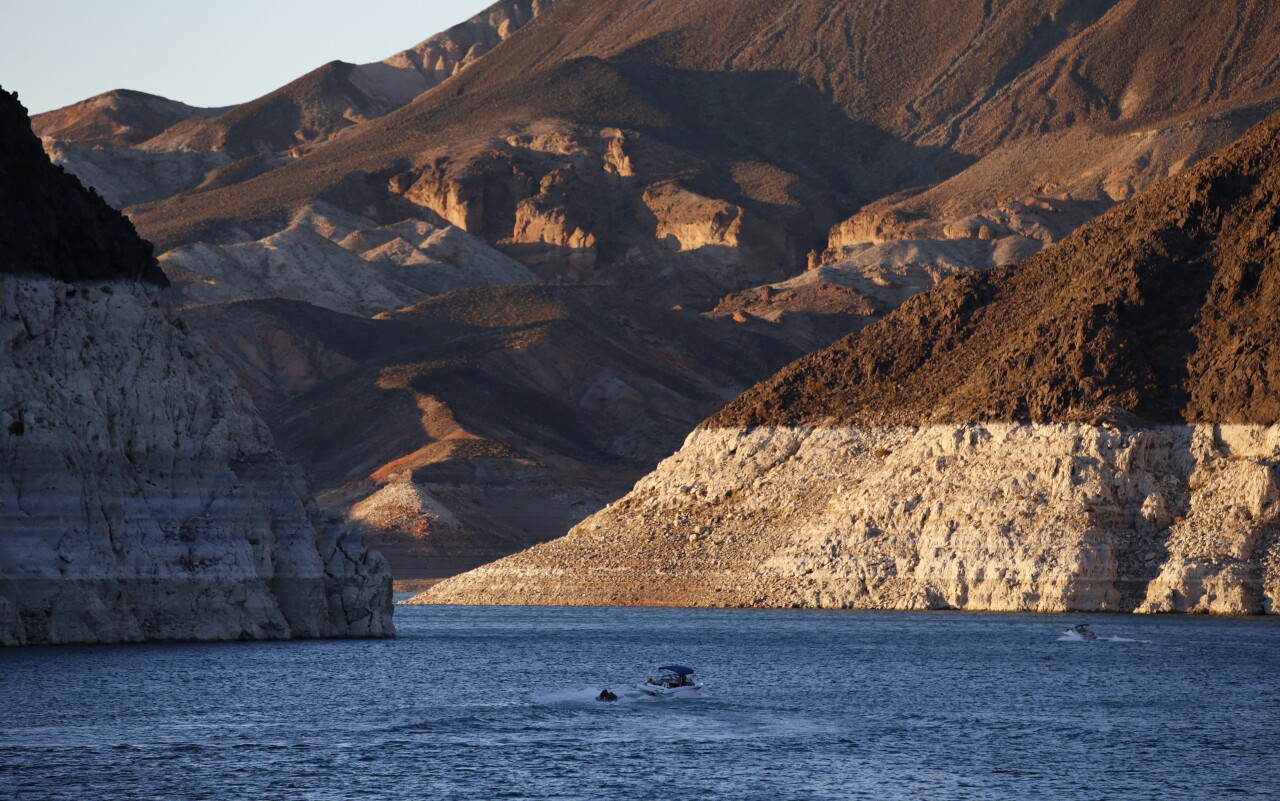DENVER — The Colorado River is regarded as the lifeblood of the American West. It provides water to more than 40 million people, supporting agriculture, hydropower and ecosystems. The current guidelines needed to manage this critical resource expire at the end of 2026, and now the question is — what will replace them?
Seven states are part of the Colorado River Basin. The Upper Basin includes Colorado, New Mexico, Utah and Wyoming, while the Lower Basin encompasses Arizona, California and Nevada. The Colorado River also provides water to two states in Mexico and is a crucial resource for 30 Tribal Nations. 40% of the water in Colorado is supplied by the Colorado River.
On Nov. 20, the Bureau of Reclamation released five options called alternatives for the future management of the Colorado River. Three of those suggestions involve "Basin-wide shared contributions," leading water experts to say those plans could mean water restrictions for Upper Basin states during dry years.

Mandatory water cuts would be new for Colorado.
Colorado River Commissioner Becky Mitchell works with water experts to negotiate on behalf of Colorado when it comes to the management of the Colorado River. While she cannot comment on the Bureau of Reclamation's five alternatives at this time, she stands behind the Upper Division States' Alternative, which was announced in March.
"The Upper Division States Alternative is supply-driven and is designed to help rebuild storage at our nation’s two largest reservoirs. The Alternative protects Lake Powell’s continued ability to release water downstream into the future to continue to meet our obligations and protect our significant rights and interests in the Colorado River," Mitchell said in a written statement. "Colorado remains committed to working collaboratively with the other Basin States, the federal government, and Tribal Nations towards a consensus approach and also stands ready to protect our State’s significant interests in the Colorado River."
Mitchell's predecessor is James Eklund, a Western water lawyer.
“I call it the hardest working river in America," Eklund said about the Colorado River. “If this basin sneezes, the rest of the nation gets a cold.”
Eklund said these alternatives presented by the Bureau of Reclamation were meant to kickstart negotiations among Colorado River Basin states trying to determine the new guidelines. The current set of guidelines, which were established in 2007, will sunset at the end of 2026.
“It's not a surprise, really, that the talks are difficult. They were when I represented the state — they were very difficult. Every state wants to maximize their own self-interest, and sometimes that can create kind of another game theory dynamic, which is the prisoner's dilemma. Everybody tries to do the best vis-a-vis themselves, and as a result, everybody kind of suffers a little bit. In this case, it's the system that suffers, and we can't afford that to happen," Eklund said. “We've got to be very efficient with how we steward the resource. There's just not a lot of wiggle room in it.”
According to Eklund, there's a divide between what the Upper and Lower Basin states want out of the new rules for the management of the Colorado River. He said Upper Basin states argue Lower Basin states must cut their water usage to balance the system. However, Lower Basin states believe the Upper Basin states have a role to play in that process as well.
“We've done some pretty innovative things in Colorado when it comes to water conservation... but we've done those voluntarily," Eklund said. “I'm a big believer in voluntary, compensated, and temporary cuts... if we implement that kind of measure when it comes to water conservation, we can do this our way and kind of control our own destiny if we don't. However, the flip side is also true, and that is, we take our hands off the wheel, and we don't control our own destiny. And that's a terrifying prospect, because then the mandatory cuts that come could be pretty draconian, and people, even in municipal Denver, could feel the impacts of those.”
The alternatives may serve as a starting point for the states. Eklund summarized all five of the suggestions as follows:
- No Action – Reversion to pre-2007 guidance, which lacks sustainability measures.
- Federal Authorities – Leverages existing federal powers to prioritize infrastructure protection.
- Federal Authorities Hybrid – Combines stakeholder proposals with federal strategies.
- Cooperative Conservation – Focuses on conservation, stewardship and flexibility.
- Basin Hybrid – A comprehensive approach combining elements from all stakeholders to maximize consensus.

Drought
The Colorado River Basin, explained
Typically, senior water rights reside with agriculture and the majority of junior water rights are municipal, Eklund said.
“If we had a event where we had to cut back our use or curtail our use, if we had to do that in order of priority, then we would end up seeing the municipal users cut off before the agricultural users," Eklund explained.
Doug Kenney has been studying the Colorado River for the last three decades, and currently serves as the director of the Western Water Policy Program, located within the University of Colorado Law School in the Getches-Wilkinson Center for Natural Resources, Energy and the Environment.
“Whether or not Colorado takes a cut, it's a very delicate issue, and it's the semantics of this," Kenney said. “Colorado has never taken a cut in terms of the Bureau of Reclamation saying you have to reduce your use, or we're going to shut off a valve or something, and you're not going to get water."
Kenney said the Bureau of Reclamation hopes the states are able to reach a new set of guidelines without having to intervene.
“What Reclamation has said in their very, very brief description of alternatives, I think, gives them enough room to explore different ratios or different scenarios by which the Upper Basin probably participates to some degree in taking those additional cuts," Kenney said. “The Lower Basin is where the use has been on the excessive side. It's twice as much water as is used upstream. If you have to make a cut, you go to look at the biggest piece of the budget, so to speak, and that's where it is in the Lower Basin.”
According to Kenney, the guidelines become increasingly important if the state of the Colorado River continues to suffer.
“The reservoirs [Lake Powell and Lake Mead] were full 25 years ago. They're about a third full today. I mean, the trend line is concerning," Kenney said. “It's always a concern to me when I hear people talk about climate change as either a hypothetical thing or a future thing. I mean, in the world of water, it's not a future thing, it's not a hypothetical thing.”
Both Kenney and Eklund explained different ways climate change impacts the Colorado River.
“You get just a little change in temperature, and stream flows drop pretty suddenly, and that's what we see in this basin. That's the reason why these reservoirs aren't full anymore," Kenney said. “It's not that the demands on the river have gone up. Pretty much every city in the Western US uses less water now than they did 30 years ago, even though there's been huge population growth, because cities have gotten really efficient about using water. That's not the problem, really. The problem is that the flows just aren't there anymore because it's hotter, growing seasons are longer, more water evaporates, soils dry out and suck up any moisture that does fall. It's just the hydrologic system is so messed up."
“If climate change is the shark that's coming to eat us, water is the teeth of that shark. So, it's the first impact that many communities will feel before you run into other consequential impacts of climate change," Eklund said. “Especially being in a landlocked state like Colorado, we're not going to see sea level rise here, but we'll see the knock on effect of people moving away from the coast, and the economic impact that will cause will be felt here in Colorado... What we will experience will be on the water front, so to speak, in our snow pack. It's resiliency when it gets hot, windy and dry... It's going to hit us in our water supply, and it's just going to dial up the pressure on us to get this right.”

State
AZ, NV and Mexico will lose same amount of Colorado River water next year
Still, Kenney and Eklund believe it is possible to reach an agreement that supports the Colorado River Basin in a way that accounts for a changing climate.
“It's frustrating because it's such a self-imposed problem, but it's such a big hole now to dig out of," Kenney said. “We can be smarter. We can pivot. The first rule of holes is, when you find yourself in a hole, stop digging. You know? We can stop digging.”
If the seven states are not able to reach an agreement regarding new guidelines for the Colorado River, litigation could be possible.
“How do you keep this discussion in the conference room and in the boardroom instead of in the courtroom? That's our challenge, and an alternative that really recognizes that every one of these geographic areas, economic sectors, industry segments, people groups, cultural groups, all of them have a valid perspective that needs to be brought to bear here," Eklund said. “We as Americans have to start treating this river basin as one resource, instead of seven different rivers and seven different jurisdictions, with 30 sovereign tribes.”
Detailed analyses will be conducted on each of the alternatives in order to prepare a Draft Environmental Impact Statement (DEIS). Then, next steps would include public feedback and collaboration to finalize new guidelines for the Colorado River starting in 2027.





